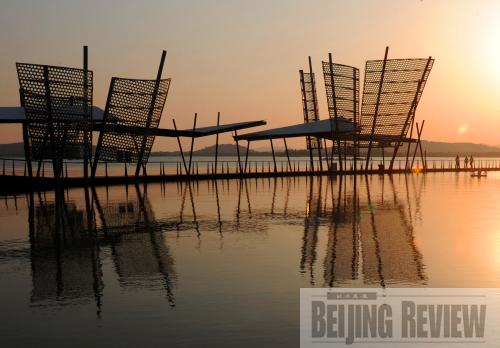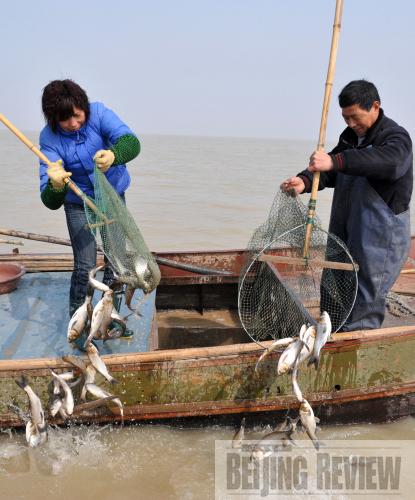|
 |
|
JIANG FAN |
Just two years ago, a layer of blue-green algae measuring up to 50 cm thick on Taihu Lake emitted a foul stench, while floating debris turned the water body into an eyesore and a blight.
These days, though, the lake's shoreline is alive with activity. Children laugh and play, anglers fish the waters and young couples pose for their wedding photos in front of picturesque reed marshes.
The only reminders of that polluted time are the boatmen working to remove the blue-green algae and silt.
East China's Taihu Lake, covering 2,338 square km, is the country's third largest freshwater body. It is a major drinking water source for the 17 million residents living nearby, according to the Ministry of Water Resources.
Algae crisis
On May 29, 2007, a blue-green algae bloom broke out, threatening water quality and disrupting drinking water supplies to about 1 million people in the city of Wuxi, Jiangsu Province.
The photosynthetic algae is a simple form of aquatic bacterial life that occurs naturally in rivers, lakes, damp soil, tree trunks, hot springs and snow. When it goes through a period of blooming it grows to the extent that it discolors the water, forms scum, produces unpleasant tastes and odors, affects shellfish and fish populations and seriously reduces water quality.
An excess of the bacteria also removes oxygen from the water, killing fish and other aquatic life, which then decay and release toxins.
Wuxi, an economically dynamic city 128 km from Shanghai, saw panic buying of bottled water and bread on May 30, 2007, the day after Taihu Lake started to give off a foul odor from the bloom.
Zhang Jing, a 26-year-old woman from Wuxi, said she would never forget the day when she awoke to find her tap water had been badly contaminated.
The bacteria had infiltrated the city's water intake from Taihu Lake and residents were forced to buy bottled water before it disappeared from market shelves.
"It was the first time in my life I realized how precious clean water is," she said. "Now I always store bottled water in time for summer, in case it happens again."
More blue-green algae outbreaks will likely occur again in Taihu Lake within the next decade, said Zhou Shengxian, Minister of Environmental Protection, on the sidelines of the Second Session of the 11th National People's Congress in March this year.
But the scale of the algae outbreak may be decreased every year thanks to intensified efforts to improve the surrounding environment, he said. "We have introduced an effective emergency mechanism for tackling water pollution."
Drinking water supplies would be ensured during outbreaks, Zhou said.
Creative approaches
"Biological treatment using fish to digest the bacteria is expected to fundamentally rehabilitate the lake," said Lin Jianhua, Head of the Taihu Lake Fishing Administration.
Tens of millions of cyanobacteria-eating fish, such as silver and grass carp, were released into the lake in March this year to curb the growth.
Lin said a silver carp could consume 50 kg of algae and other plankton life in the course of gaining 1 kg in weight. With that kind of eating habit, he said, researchers have calculated that it would take 100 million fish to clean the lake.
"There has always been algae in the lake," said 42-year-old fisherman Qian Fenglin. "But in the past there were also many more fish and shrimp that could eat the algae. In recent years, we have caught less fish and the bacteria started to boom."
Taihu connects with many rivers. So the Jiangsu Provincial Government decided to launch a comprehensive treatment project for the 15 main rivers flowing into the lake. In 2008, the provincial government decided to promote the "river caretaker system" to manage the 15 main rivers.
Within the system, provincial and local leaders cooperate with each other and promote comprehensive management of all the watersheds.
"They would be held directly responsible for any pollution threatening water quality," said Zhu Tiejun, Deputy Director of the Jiangsu Provincial Environmental Protection Bureau.
He said some places in the province have even set up caretaker systems with four levels of stewardship that bring together the city, county, township and village. Authorities implemented seamless management of the rivers and strengthened the responsibilities of leaders at different levels to improve the rivers' water quality, Zhu said.
The Caoqiao River runs through Wuxi's Wujin District and Yixing County. Its water quality was rated worse than grade 5 after the river had been reduced to support no biological functions.
China has a five-grade system of measuring water quality. Water that is classified as grades 1-3 is potable, while grade 4 can be used only by industry, and grade 5 only for irrigation.
After Zhao Kezhi, Vice Governor of Jiangsu, became the provincial caretaker of the river, many problems were resolved and the water quality fundamentally changed. The water quality has improved to grade 5.
Stopping the source
"The blue-green algae problem is in Taihu Lake but the root of the problem is on the shore," said Liu Yamin, Director of the Wuxi Environmental Protection Bureau. "The key to solving the problem is to cut and treat pollution discharge into the lake."
 |
|
BIOLOGICAL TREATMENT: Fishermen release algae-eating fish into Taihu Lake on March 6. More than 530,000 silver carp were released into the lake that day (WANG DINGCHANG) |
Liu said authorities have devised an estimated 1,600 environmental projects aimed at restoring the Taihu Lake ecosystem. They intend to invest 80 billion yuan ($11.7 billion) before 2012 and a further 28 billion yuan ($4.1 billion) between 2012 and 2020.
The Taihu basin is at the core of the Yangtze River Delta and lies in China's richest region. A densely packed population and a high level of industrial development surround it.
The Taihu ecosystem has borne the brunt of the region's fast economic development. But now the area's authorities have refocused on creating sustainable development, even if it means slowing the high rate of growth.
According to statistics from the Jiangsu Provincial Government, the province has spent 5 billion yuan ($732 million) to build 3,500 km of sewage pipes, which have effectively prevented direct sewage discharges into the Taihu basin.
More than 170 sewage plants have been built or are under construction in the basin, with a total daily disposal capacity of 4 million tons at the end of 2008.
Now 37 of the 53 monitored river boundary sections on both sides of Taihu Lake have met water quality standards, an improvement of 13.2 percent year on year, according to figures from the provincial environmental protection bureau.
The bureau hopes to have all 53 sections reach the standard by the end of 2009. To accomplish the goal, scientists say discharges of nitrogen, ammonia and phosphorous need to be reduced by 5 percent.
Top Jiangsu officials have said the province would increase efforts to treat pollutants, accelerate industrial restructuring and promote an environmental compensation mechanism to reach the target.
The mechanism, introduced in the province last year, stipulates that cities on the upper reaches of Taihu must compensate their neighbors in the lower reaches if their pollutant discharges exceed the maximum limit.
"The mechanism makes clear who is responsible for the excessive discharge of pollutants, and in turn, encourages pollution reduction by imposing compensation payments," said Chen Jianping, Director of the Pollution Control Department of the Wuxi Environmental Protection Bureau. The first compensation package was finalized in the third quarter of 2008.
Wuxi Mayor Mao Xiaoping said Taihu Lake's protection also requires coordinated efforts from nearby cities in Jiangsu and Zhejiang provinces, as well as from Shanghai, which recently acceded to the mechanism.
Mao said Wuxi is also promoting the compensation system within its own waterways.
Apart from compensation, authorities have also launched other measures.
Some 4,326 small factories have been shut down across the province in the last two years, according to figures from the provincial working team on the renovation of chemical companies.
Neighboring cities have cooperated in a ecological approach to the pollution, with more than 650 hectares of wetlands being restored into reed marshes and a 200-meter-wide forest belt that has been planted along the shore.
Meanwhile, harvested blue-green algae has been put to good use by the Wuxi authorities as a biomass fuel source for electricity generation and also as fertilizer for young trees.
The latest research by the National Development and Reform Commission shows the blue-green algae has been reduced by 73 percent from its 2007 level. Today, about 20 million cyanobacterial cells live in every liter of lake water, compared to more than 100 million two years ago.
Pollutants such as nitrogen and phosphate have been reduced by 20 percent since last year.
Despite of that, water experts warned that Taihu Lake has become prone to bacterial outbreaks in warm weather and will become a serious danger if the level of pollutants increases. Keeping the lake clean will be a long-term process, they said. | 